DEXA Scan: Essential Guide to Bone Density and Body Composition
A DEXA scan measures your bone density and body composition. It’s key in detecting osteoporosis early and assessing your overall bone health. In this article, we’ll explain how the scan works, its benefits, and what to expect before, during, and after the procedure.
Key Takeaways
- A DEXA scan measures bone density and body composition, providing crucial insights for diagnosing conditions like osteoporosis.
- The scan is a quick, non-invasive procedure utilizing low-dose x-rays to generate precise images of bone structure, making it the gold standard for bone health assessment.
- Regular DEXA scans are recommended based on individual risk factors and can track changes in bone density over time to inform health and fitness strategies.
What is a DEXA Scan?
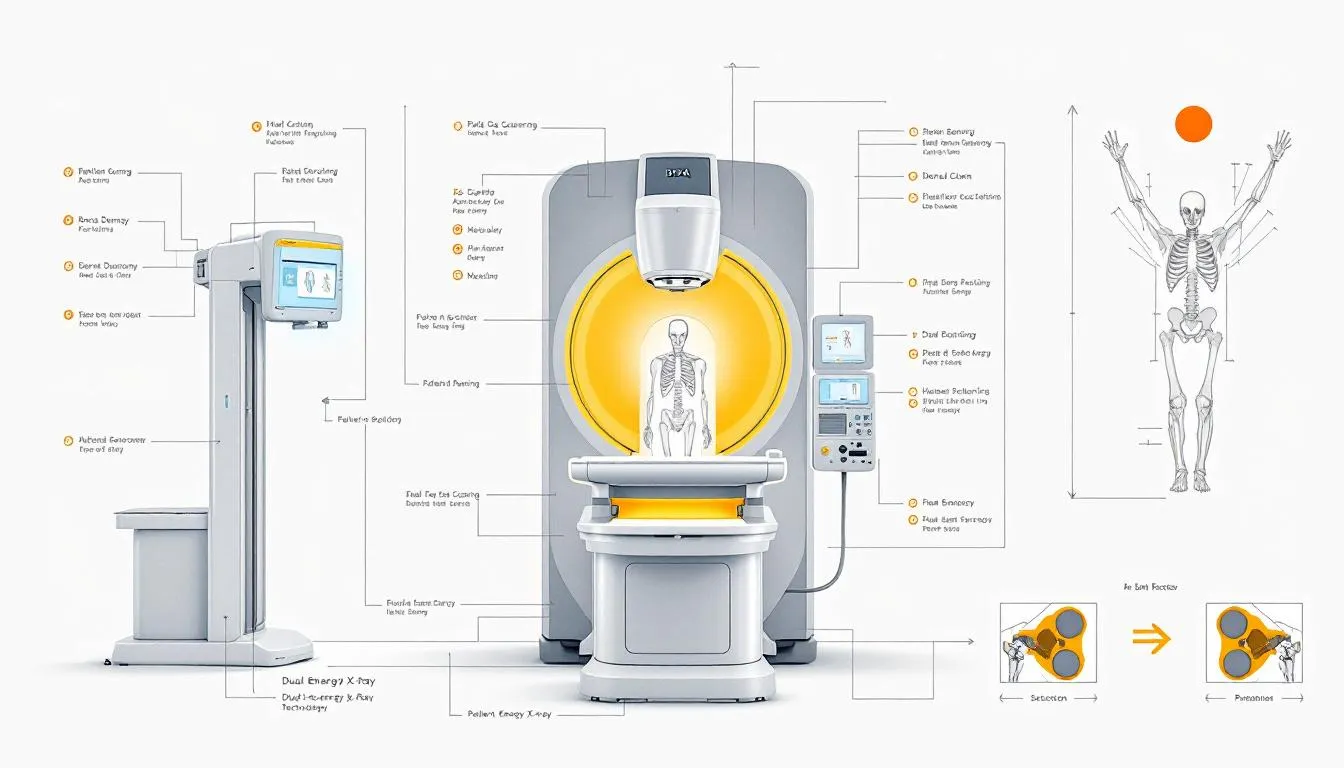
A DXA scan, short for Dual-Energy X-ray Absorptiometry, is an advanced technology designed to measure bone density and assess bone health. This rapid and non-invasive bone density test primarily focuses on evaluating bone mineral density (BMD), providing critical insights into the strength and mineral content of your bones. Specific areas such as the spine and hips are typically examined, as these are common sites for bone loss and fractures. A dexa test, along with bone density tests and bone densitometry, are essential in this process.
A DEXA scan aims to detect bone loss early and prevent fractures, serving as an essential tool for diagnosing osteoporosis and other bone-related conditions. A DEXA scan provides precise data on bone density, muscle mass, and fat distribution, offering a comprehensive overview of your overall health.
How Does a DEXA Scan Work?
DEXA scans utilize a thin, invisible beam of low-dose x-rays with two distinct energy levels to differentiate between soft tissue and bone. When the x-rays pass through your body, one energy peak is primarily absorbed by soft tissue, while the other is absorbed by bone, creating a detailed image of your bone structure.
Specialized software in the DEXA machine then computes and displays the bone mineral density on a screen, allowing healthcare providers to assess your bone health accurately. This sophisticated technology ensures that the results are both reliable and easy to interpret, making DEXA scans the gold standard for bone density testing.
Benefits of DEXA Scans
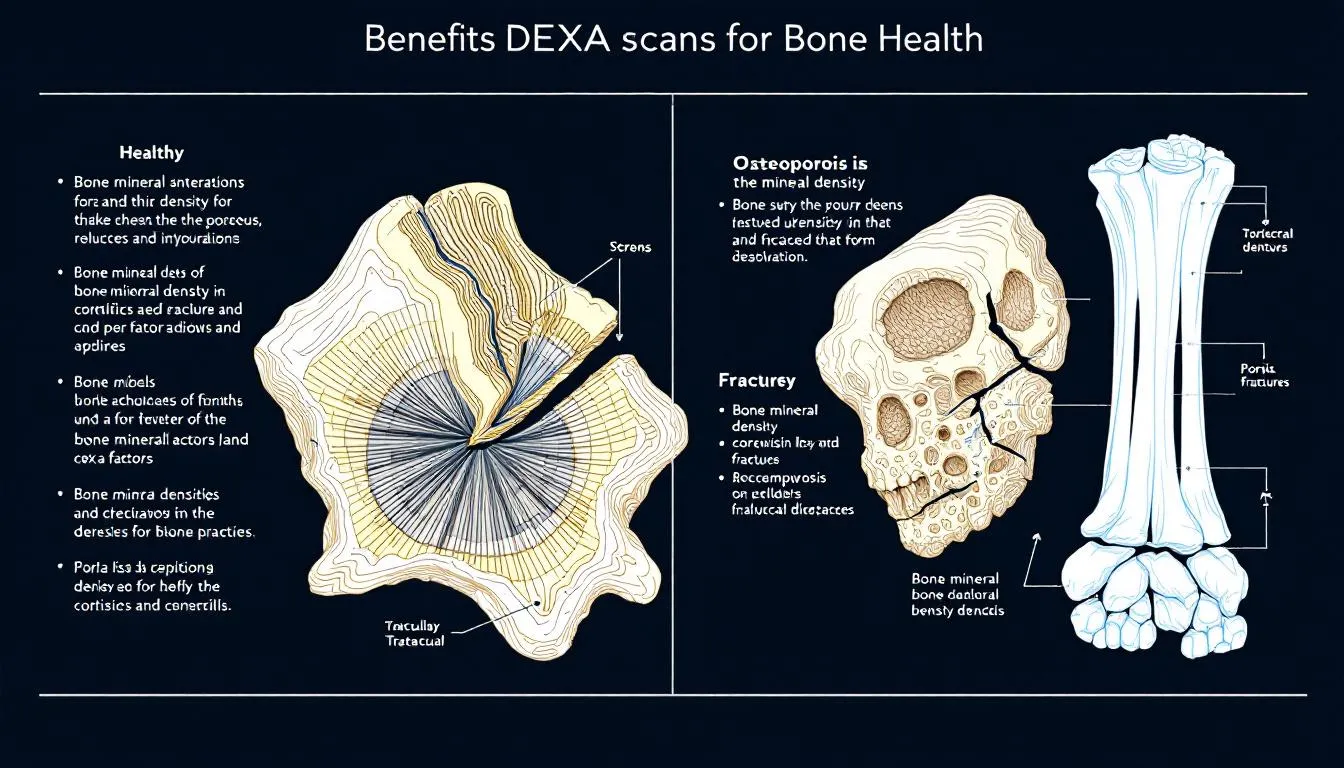
One of the most significant benefits of DEXA scans is the early detection of conditions such as osteoporosis and osteopenia, which can lead to an increased risk of fractures. Often, bone loss occurs silently and without symptoms until a fracture happens, making early detection through DEXA scans crucial. Early identification of weak bones allows healthcare providers to implement strategies to strengthen bones and reduce the risk of broken bones.
DEXA scans also provide a comprehensive analysis of your body composition, including fat, muscle, and bone density. The detailed report includes body composition percentages and mass, offering valuable insights into your overall health. This information is essential for evaluating health risks and developing personalized health and fitness strategies.
Additionally, DEXA scans highlight visceral fat and fat mass, a key risk factor for various health conditions, including insulin resistance and metabolic syndrome. Monitoring visceral fat and other risk factors whole body composition metrics helps you make informed decisions about diet, exercise, and overall lifestyle.
Who Should Get a DEXA Scan?
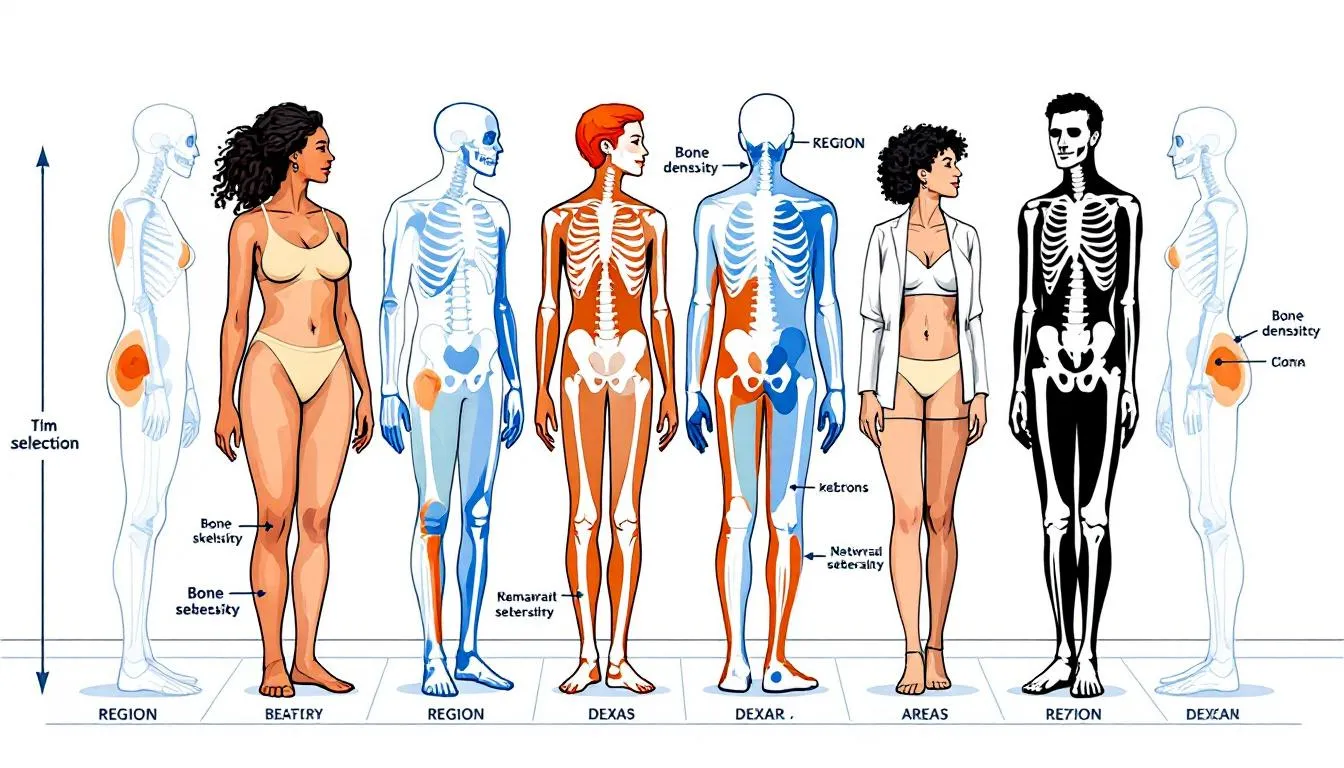
Women aged 65 and older are at a higher risk of osteoporosis and should consider getting a DEXA scan to monitor their bone health and healthy bone density. Men over the age group of 50, although at a lower osteoporosis risk than women, can also benefit from regular bone density testing. Postmenopausal women, in particular, should be vigilant about their bone density due to the relationship between bone density and estrogen levels, as recommended by the National Osteoporosis Foundation.
Individuals with certain medical conditions, such as intestinal disorders or multiple sclerosis, may also be advised to undergo a DEXA scan. These conditions can affect bone density, making regular monitoring essential. Understanding your bone density results can help manage and mitigate the risk of developing osteoporosis and other bone density issues, especially in individuals with low bone density.
Preparing for a DEXA Scan
Preparing for a DEXA scan is straightforward but requires a few essential steps. First, avoid taking any calcium supplements or multivitamins containing calcium for at least 24 hours before the scan. This precaution helps ensure that the scan results are as accurate as possible. Additionally, wear loose, non-bulky clothing without metal zippers or buttons to avoid interference with the imaging process.
All metal items and jewelry must be removed before the scan to prevent any artifacts on the images. Following these simple preparation guidelines helps ensure that your DEXA scan provides the most accurate assessment of your bone density and body composition.
What to Expect During a DEXA Scan
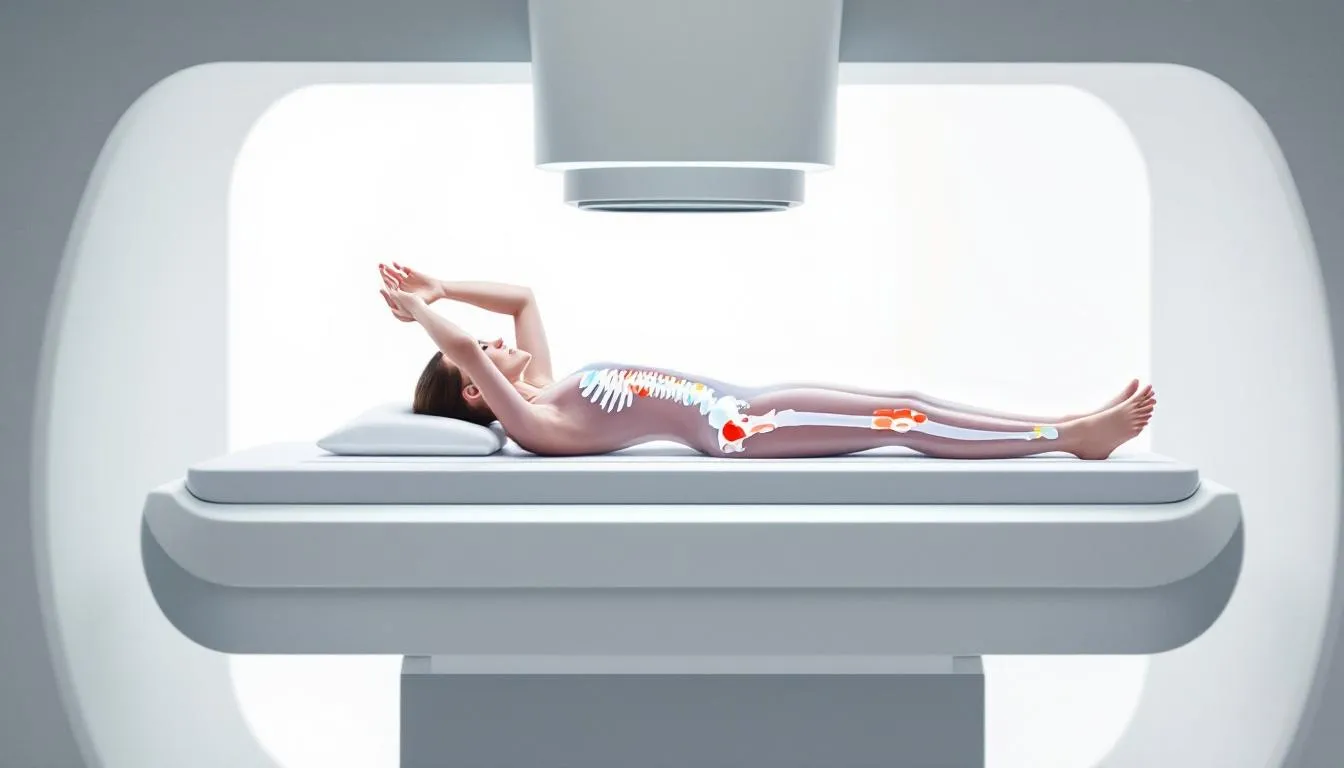
A DEXA scan is a quick, painless procedure designed to measure bone density and body composition accurately. The entire process usually lasts around 30 minutes, depending on how many bones need to be scanned. Patients are typically advised to limit physical activity before the scan and to fast for two hours to ensure clearer results.
During the scan:
- You’ll lie on a special x ray table while a scanning arm captures images of your bones.
- Comfort measures such as foam blocks and a padded table may be used to maintain proper body alignment.
- Since no needles are involved, the procedure is entirely non-invasive.
- The procedure is performed on an outpatient basis, including a whole body scan, a ct scan, and imaging tests.
Understanding Your DEXA Scan Results
Interpreting your DEXA scan results involves understanding T-scores and Z-scores. The T-score compares your bone density to that of a healthy young adult of the same sex and ethnicity. Key points to understand include:
- A T-score between -1 and -2.5 indicates low bone mass.
- A T-score below -2.5 signifies osteoporosis.
- Each standard deviation below the normal bone density T-score is associated with a doubling of fracture risk.
Z-scores, on the other hand, compare your bone density to the average bone density of age- and sex-matched peers. These scores are crucial for diagnosing conditions like osteopenia and osteoporosis, enabling early intervention and treatment to improve bone health.
Frequency of DEXA Scans
Scheduling DEXA scans recommendations based on risk levels:
- General wellness: every 6 to 12 months.
- High-risk individuals (e.g., family history of osteoporosis or taking high doses of steroids): every two years.
- Moderate-risk individuals: every 3 to 5 years.
Regular follow-up DEXA scans help track changes in bone density over time, facilitating ongoing evaluation of bone health. Women aged 50 to 64 with specific risk factors, such as a parental history of hip fractures, should also consider a DEXA scan.
Safety and Accuracy of DEXA Scans
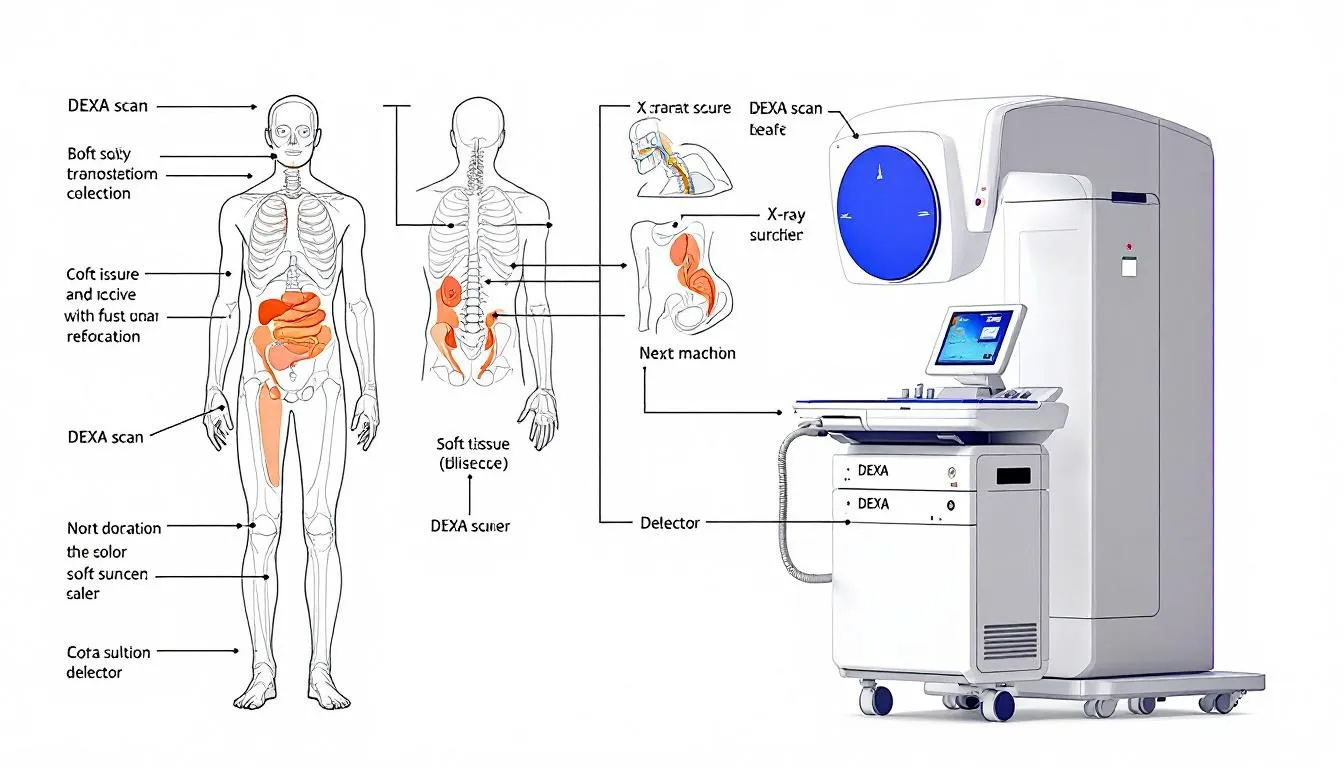
DEXA scans are renowned for their accuracy and repeatability, making them highly reliable for monitoring bone strength and body composition. The radiation dose from a dxa scans is minimal, comparable to that of a standard chest x, ensuring that the procedure is safe for regular use.
Radiology professionals take measures to minimize radiation exposure by using controlled x-ray beams and dose control methods. Although there is a very slight increase in cancer risk associated with ionizing radiation exposure, DEXA scans are generally considered safe and provide invaluable information for assessing bone health.
Comparing DEXA Scans to Other Body Composition Tests
DEXA scanning differs significantly from Body Mass Index (BMI) measurements, as it directly measures body fat and shows its distribution, while BMI only compares height and weight. DEXA scans offer superior accuracy in assessing body fat distribution compared to bioimpedance analysis, which can be less precise.
DEXA scans offer detailed insights into regional differences in fat and muscle distribution, providing a more comprehensive analysis of body composition. This level of detail makes DEXA scans a preferred method over BMI and bioimpedance for those seeking accurate and actionable health information.
Enhancing Health Insights with DEXA Scans
Combining DEXA scans with health and hormone blood panels provides a more comprehensive view of your overall health. These scans can help identify hormonal imbalances that affect metabolism and fat storage, offering valuable insights into your health and indicating the need for medical tests and further medical tests.
Understanding your body composition through DEXA scans can optimize health and fitness strategies, allowing you to make informed decisions about diet and exercise. Tracking visceral fat is crucial for assessing risks related to insulin resistance and metabolic syndrome, making DEXA scans an essential tool for comprehensive health monitoring.
DEXA scans can also aid in monitoring changes in muscle mass due to hormonal fluctuations, such as testosterone or thyroid hormones. Regular testing of health and hormone panels is recommended every 6–12 months for general wellness and every 3–6 months for potential issues.
Finding a DEXA Scan Location Near You
Finding a DEXA scan location near you is simple with the help of online tools. Entering your city or state quickly locates facilities that offer DEXA scans.
It’s essential to select a location that matches your health goals and can provide specialized services if needed.
Summary
In summary, DEXA scans are an invaluable tool for assessing bone density and body composition. They provide early detection of bone-related conditions, offer comprehensive health insights, and are safe and accurate. Understanding how DEXA scans work and who should get them can help you take proactive steps towards maintaining healthy bones and overall wellness.
Whether you’re at high risk for osteoporosis or simply looking to optimize your health, regular DEXA scans can provide the information you need to make informed decisions. Take charge of your health today by considering a DEXA scan and unlocking the secrets to a stronger, healthier you.
Frequently Asked Questions
What is a DEXA scan?
A DEXA scan is a sophisticated x-ray technique employed to evaluate bone density and overall bone health. It provides critical insights into the risk of osteoporosis and fractures.
How does a DEXA scan work?
A DEXA scan employs a low-dose x-ray beam to distinguish between soft tissue and bone, yielding precise measurements of bone mineral density. This process ensures a reliable assessment of bone health.
Who should consider getting a DEXA scan?
Individuals such as women aged 65 and older, men over 50, and those with specific health conditions or risk factors are advised to consider getting a DEXA scan. This scan helps assess bone density and determine osteoporosis risk effectively.
How often should I get a DEXA scan?
For general wellness, it is advisable to have a DEXA scan every 6 to 12 months. High-risk individuals should undergo scanning more frequently, while those at moderate risk may opt for a scan every 3 to 5 years.
Are DEXA scans safe?
DEXA scans are indeed safe, as they involve minimal radiation exposure similar to that of a standard x-ray, while offering valuable insights into bone health.
